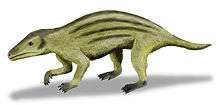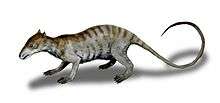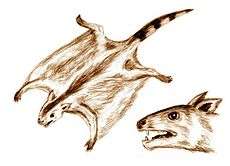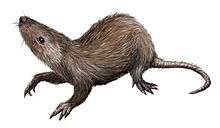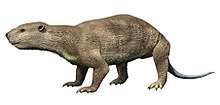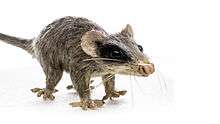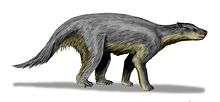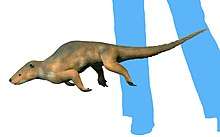Protungulatum
Protungulatum ('first ungulate') is an extinct genus of mammal first found in the Bug Creek Anthills in northeastern Montana. The Bug Creek Anthills were initially believed to be Late Cretaceous (latest Maastrichtian) because of the presence of the remains of non-avian dinosaurs and common Cretaceous mammals, but these were later shown to have been reworked[1] from Late Cretaceous strata, and consequently the Bug Creek Anthills are currently believed to be Early Paleocene (Puercan) in age. Remains from the Ravenscrag Formation of Saskatchewan, Canada have been assigned to P. donnae. These remains may also be Cretaceous in age, but the age of the Ravenscrag Formation is not entirely certain. In 2011, remains of a new species of Protungulatum, P. coombsi, from the Hell Creek Formation, which is definitely Late Cretaceous (Maastrichtian) in age, proved that Protungulatum was present in both the Cretaceous and the Paleocene.[2] It was initially assigned to the order condylarthra, a group of archaic "ungulates", that is now known to be polyphyletic. According to Archibald et al. (2011), Protungulatum is not even definitely a placental mammal. Some studies have found it to be close to Cetartiodactyla,[3] but the most recent analysis holds it to be a non-placental eutherian.[4]
| Protungulatum | |
|---|---|
| Jaw | |
| Scientific classification | |
| Kingdom: | |
| Phylum: | |
| Class: | |
| Infraclass: | |
| Genus: | Protungulatum Sloan and Van Valen, 1965 |
| Species | |
| |
The date of divergence of Protungulatum and Placentalia is approximately 75 Ma.[5]
References
- A derived or reworked fossil is a fossil found in rock made significantly later than when the fossilized animal or plant died: it happens when a hard fossil is freed from a soft rock formation by erosion and redeposited in a currently forming sedimentary deposit.
- Archibald, J. David; Zhang, Yue; Harper, Tony; Cifelli, Richard L. (May 6, 2011). "Protungulatum, confirmed Cretaceous occurrence of an otherwise Paleocene eutherian (placental?) mammal" (PDF). Journal of Mammalian Evolution. 18 (3): 153–161. doi:10.1007/s10914-011-9162-1. Archived from the original (PDF) on March 3, 2016. Retrieved April 28, 2013.
- Wible, J. R.; Rougier, G. W.; Novacek, M. J.; Asher, R. J. (2007). "Cretaceous eutherians and Laurasian origin for placental mammals near the K/T boundary". Nature. 447 (7147): 1003–1006. doi:10.1038/nature05854. PMID 17581585.
- Halliday, Thomas J. D. (2015). "Resolving the relationships of Paleocene placental mammals" (PDF). Biological Reviews. 92: 521–550. doi:10.1111/brv.12242. PMC 6849585. PMID 28075073.
- Eutherians experienced elevated evolutionary rates in the immediate aftermath of the Cretaceous–Palaeogene mass extinction

